From the Trenches
Iceland’s Young Migrant
By DANIEL WEISS
Monday, June 13, 2016
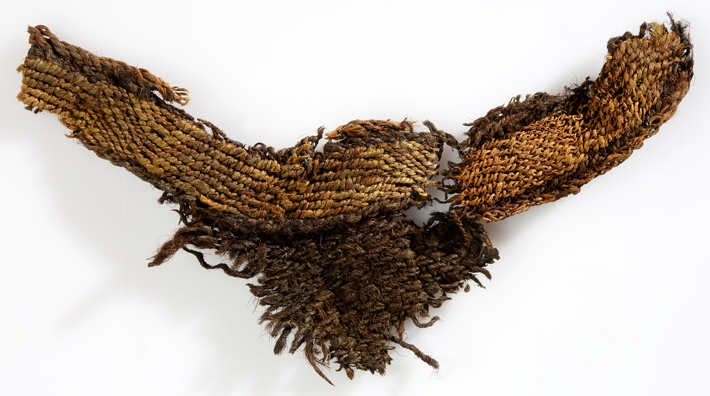
The remains of the “Woman in Blue,” discovered in 1938 in eastern Iceland, have been subjected to a battery of tests that have revealed new details about her origins and life history. Chief among these is that the woman, named after a blue-dyed apron she was buried in, appears to have come to Iceland during its early settlement period. Radiocarbon dating of one of her teeth suggests that she was born around A.D. 900, while settlement is thought to have begun around A.D. 871. Isotopic analyses of the same tooth indicate that, at around age five, her diet shifted from one composed primarily of land animals to one including a mix of seafood and land animals. “This implies that she moved to Iceland some time after the age of five,” says Joe Walser of the National Museum of Iceland. The analyses suggest that she spent the early part of her life in southern Denmark or the British Isles.
Fragments of the woman’s apron and another garment show an amalgam of Nordic and Celtic weaving and spinning techniques using wool that appears to have been sourced locally. She was also buried with grave goods including Scandinavian-style copper-alloy brooches, an imported soapstone spindle whorl, and an iron tool with a bone handle.
A Villa under the Garden
By JASON URBANUS
Monday, June 13, 2016
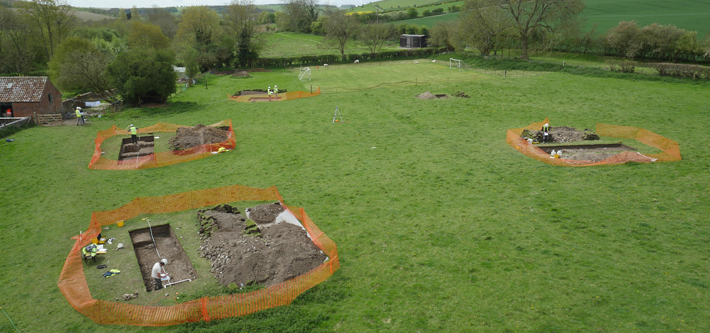
Archaeologists from Historic England and the Salisbury Museum were called to investigate a well-preserved Roman mosaic discovered near Tisbury in Wiltshire, England. The red, white, and blue ancient floor was found just 18 inches belowground when a local resident was installing an electrical cable in his garden. After a week of geophysical survey and excavation, experts concluded that the mosaic was part of a large Roman villa complex that was built between A.D. 175 and 220. Due to its size and state of preservation, the villa’s discovery is being characterized as “unprecedented in recent years.”
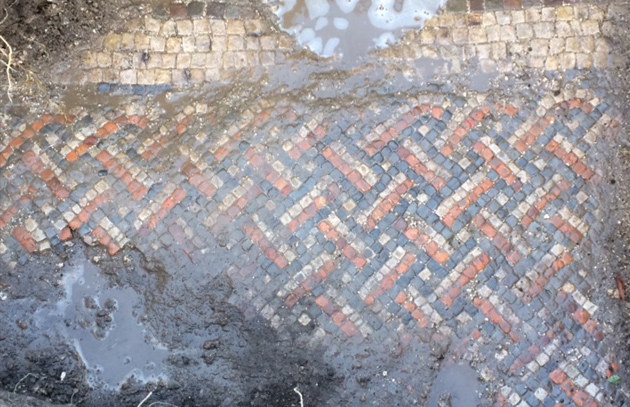 The walls of the ground floor, which contained as many as 25 rooms, were preserved to a height of five feet. The double-courtyard villa is believed to have stood three stories high, and may have rivaled the most opulent Roman villas in England. In the brief investigation, archaeologists uncovered evidence of the ancient family’s wealth, including coins, jewelry, and even discarded oyster shells—the shellfish would have been transported from the coast 45 miles away in buckets of salt water.
The walls of the ground floor, which contained as many as 25 rooms, were preserved to a height of five feet. The double-courtyard villa is believed to have stood three stories high, and may have rivaled the most opulent Roman villas in England. In the brief investigation, archaeologists uncovered evidence of the ancient family’s wealth, including coins, jewelry, and even discarded oyster shells—the shellfish would have been transported from the coast 45 miles away in buckets of salt water.
Occupation of the site lasted until the seventh century, and researchers are hoping that further investigation can reveal more about the comparatively little-known historical period between the collapse of Roman Britain and the beginning of the Anglo-Saxon era.
Fit for a War God
By JARRETT A. LOBELL
Monday, June 13, 2016
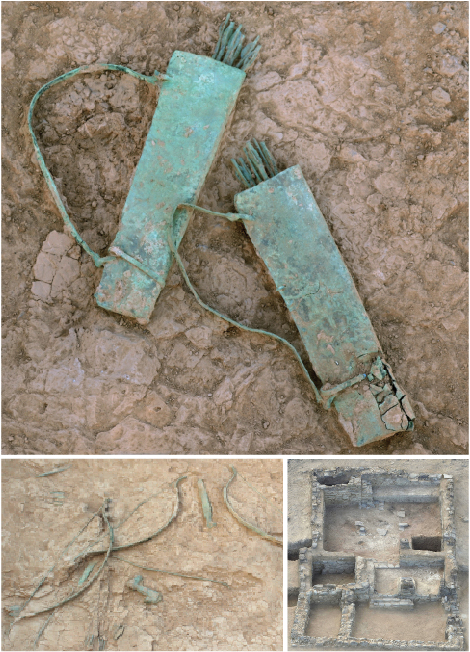 Archaeologists from the French National Center for Scientific Research working in a large building at the site of Mudhmar East near the city of Adam in Oman have made an “exceptional find.” Inside the structure, which is thought to have had a religious function, the team uncovered a collection of bronze weapons dating to between 900 and 600 B.C. The metal artifacts—two very rare quivers (ordinarily made of leather) with arrows, five battleaxes, five daggers, 50 arrowheads, and five bows, are too small to have been used in combat and were, explains project director Guillaume Gernez, perhaps intended as offerings to a war god. This region of the Arabian Peninsula, which sits at an important crossroads of ancient trade routes on the border between Oman’s desert and oases, is almost entirely archaeologically unexplored.
Archaeologists from the French National Center for Scientific Research working in a large building at the site of Mudhmar East near the city of Adam in Oman have made an “exceptional find.” Inside the structure, which is thought to have had a religious function, the team uncovered a collection of bronze weapons dating to between 900 and 600 B.C. The metal artifacts—two very rare quivers (ordinarily made of leather) with arrows, five battleaxes, five daggers, 50 arrowheads, and five bows, are too small to have been used in combat and were, explains project director Guillaume Gernez, perhaps intended as offerings to a war god. This region of the Arabian Peninsula, which sits at an important crossroads of ancient trade routes on the border between Oman’s desert and oases, is almost entirely archaeologically unexplored.
A Life Story
By ROGER ATWOOD
Monday, June 13, 2016
Peruvian archaeologists have found the 4,600-year-old remains of a woman decked out in finery, including a shell necklace, bone brooches, and blankets made of cotton and woven reeds. The bones were discovered at Áspero, a major site of the north-coast Caral civilization, the oldest known urban society in the Americas, which dates to four millennia before the Inca. “We can interpret that, some 4,600 years before the present, women had already reached significant positions in society,” says archaeologist Ruth Shady Solís. The brooches in particular, carved into bird and monkey designs, point to “a woman of prestige.” The necklace’s shells must have been brought from Peru’s far north coast and the Amazon lowlands, both hundreds of miles away, further proof of her high status. Despite the fancy accessories, the woman, who was between 40 and 50 years old when she died, saw trauma in life. She had three major bone fractures, likely caused by a fall, and a skull deformation.
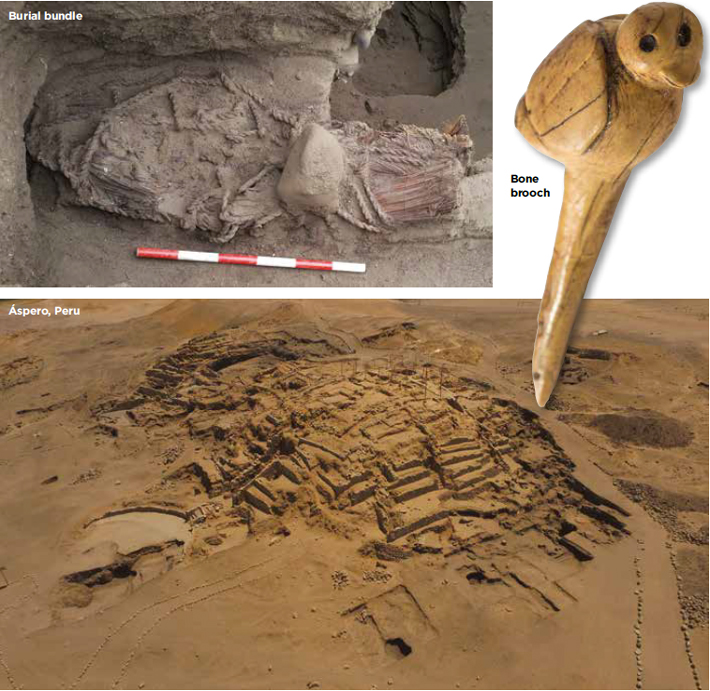
Proof in the Prints
By DANIEL WEISS
Monday, June 13, 2016
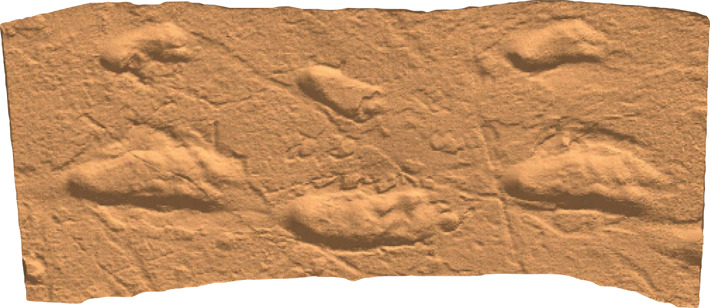
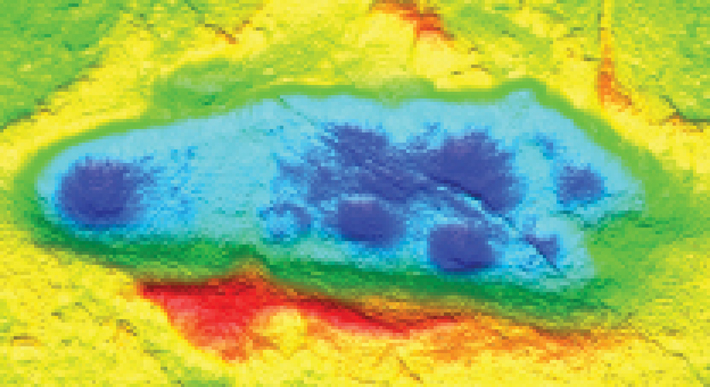 In 1976, paleoanthropologist Mary Leakey discovered the oldest known hominin footprints. The footprints, in Laetoli, Tanzania, have been dated to around 3.66 million years ago and are thought to have been left by members of the species Australopithecus afarensis. They consist of two parallel tracks: undisturbed prints from a single individual and a set of overlapping prints from at least two ancient primates.
In 1976, paleoanthropologist Mary Leakey discovered the oldest known hominin footprints. The footprints, in Laetoli, Tanzania, have been dated to around 3.66 million years ago and are thought to have been left by members of the species Australopithecus afarensis. They consist of two parallel tracks: undisturbed prints from a single individual and a set of overlapping prints from at least two ancient primates.
In the decades since the discovery, attention has focused on the undisturbed prints, in part because the overlapping ones have been considered too fragmentary to study. Experts have estimated that the individual who left the undisturbed prints stood just over four feet, three inches, and walked at around 1.4 miles per hour. However, there has been extended debate over how efficiently this individual’s feet worked compared with those of modern humans. Formulating answers to this question has been complicated by the limited sample size—a single track from just one individual.
But now, a team at Bournemouth University in England has developed a software package called DigTrace and created a digital model of the footprints left by one of the other individuals. The team used the software, which is also being applied to modern crime scene analysis, to create 3-D scans of the overlapping footprints and isolate one set. They estimate that the individual who left these was around five feet tall, and walked at approximately the same pace as the individual who left the undisturbed prints. Team leader Matthew Bennett says that comparison of the two sets of footprints suggests that the feet of these individuals worked at a level of efficiency similar to that of modern humans. “This debate has raged for 40 years based on the gait of one individual representing an entire species,” Bennett adds. “Now, at least, we’re making the debate on the basis of two individuals.”
Advertisement
Advertisement
IN THIS ISSUE
From the Trenches
Is it Esmeralda?
Off the Grid
New Dates for the Oldest Cave Paintings
Fact-Checking Lawrence of Arabia
Etruscan Code Uncracked
Naval Mystery Solved
Off with Their Heads
Cursing the Competition
Proof in the Prints
Fit for a War God
A Life Story
A Villa under the Garden
Iceland’s Young Migrant
Advertisement

Recent Issues
-
 May/June 2024
May/June 2024
-
 March/April 2024
March/April 2024
-
 January/February 2024
January/February 2024
-
 November/December 2023
November/December 2023
-
 September/October 2023
September/October 2023
-
 July/August 2023
July/August 2023
-
 May/June 2023
May/June 2023
-
 March/April 2023
March/April 2023
-
 January/February 2023
January/February 2023
-
 November/December 2022
November/December 2022
-
 September/October 2022
September/October 2022
-
 July/August 2022
July/August 2022
-
 May/June 2022
May/June 2022
-
 March/April 2022
March/April 2022
-
 January/February 2022
January/February 2022
-
 November/December 2021
November/December 2021
-
 September/October 2021
September/October 2021
-
 July/August 2021
July/August 2021
-
 May/June 2021
May/June 2021
-
 March/April 2021
March/April 2021
-
 January/February 2021
January/February 2021
-
 November/December 2020
November/December 2020
-
 September/October 2020
September/October 2020
-
 July/August 2020
July/August 2020
-
 May/June 2020
May/June 2020
-
 March/April 2020
March/April 2020
-
 January/February 2020
January/February 2020
-
 November/December 2019
November/December 2019
-
 September/October 2019
September/October 2019
-
 July/August 2019
July/August 2019
-
 May/June 2019
May/June 2019
-
 March/April 2019
March/April 2019
-
 January/February 2019
January/February 2019
-
 November/December 2018
November/December 2018
-
 September/October 2018
September/October 2018
-
 July/August 2018
July/August 2018
-
 May/June 2018
May/June 2018
-
 March/April 2018
March/April 2018
-
 January/February 2018
January/February 2018
-
 November/December 2017
November/December 2017
-
 September/October 2017
September/October 2017
-
 July/August 2017
July/August 2017
-
 May/June 2017
May/June 2017
-
 March/April 2017
March/April 2017
-
 January/February 2017
January/February 2017
-
 November/December 2016
November/December 2016
-
 September/October 2016
September/October 2016
-
 July/August 2016
July/August 2016
-
 May/June 2016
May/June 2016
-
 March/April 2016
March/April 2016
-
 January/February 2016
January/February 2016
-
 November/December 2015
November/December 2015
-
 September/October 2015
September/October 2015
-
 July/August 2015
July/August 2015
-
 May/June 2015
May/June 2015
-
 March/April 2015
March/April 2015
-
 January/February 2015
January/February 2015
-
 November/December 2014
November/December 2014
-
 September/October 2014
September/October 2014
-
 July/August 2014
July/August 2014
-
 May/June 2014
May/June 2014
-
 March/April 2014
March/April 2014
-
 January/February 2014
January/February 2014
-
 November/December 2013
November/December 2013
-
 September/October 2013
September/October 2013
-
 July/August 2013
July/August 2013
-
 May/June 2013
May/June 2013
-
 March/April 2013
March/April 2013
-
 January/February 2013
January/February 2013
-
 November/December 2012
November/December 2012
-
 September/October 2012
September/October 2012
-
 July/August 2012
July/August 2012
-
 May/June 2012
May/June 2012
-
 March/April 2012
March/April 2012
-
 January/February 2012
January/February 2012
-
 November/December 2011
November/December 2011
-
 September/October 2011
September/October 2011
-
 July/August 2011
July/August 2011
-
 May/June 2011
May/June 2011
-
 March/April 2011
March/April 2011
-
 January/February 2011
January/February 2011
Advertisement






